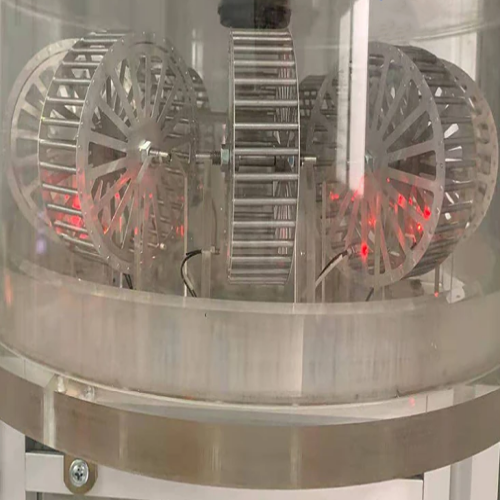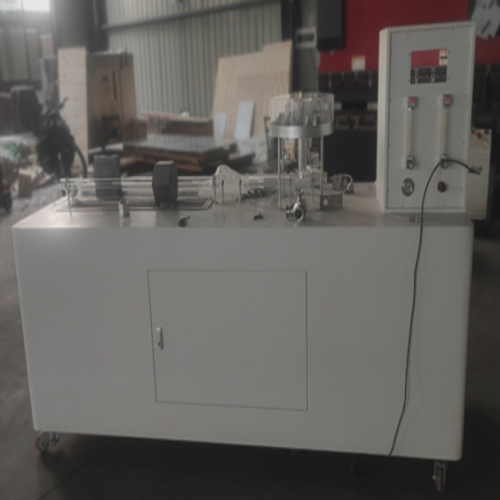Time: Popularity:0times
The Material Smoke Toxicity Test Apparatus quantitatively analyzes the toxicity of smoke generated by material combustion by precisely simulating fire pyrolysis conditions, following strict international safety standards.
Annular Furnace Heating: Utilizes an electrically heated annular furnace with a temperature range of 300°C–1200°C, static temperature control accuracy of ±0.5°C, and dynamic fluctuation ≤±2.5°C. It moves axially at 10 mm/min, fully replicating the process from smoldering to open flame.
Sample Handling: The sample is placed in a quartz boat (standard mass 10±0.1 g) within a quartz tube (inner diameter 47 mm, length ≥600 mm) to ensure uniform heat distribution.
Carrier gas (air) flow rate is precisely controlled at 0–20 L/min by a rotameter. The generated smoke is switched via a three-way valve, thoroughly mixed with diluent gas in a mixing chamber, and finally delivered to the exposure chamber. The smoke duct has a nominal diameter of 36±1 mm to minimize flow resistance.
The exposure chamber is made of transparent plexiglass with a volume of approximately 10 L, accommodating up to 10 mice simultaneously. Mice are placed in freely rotating aluminum cages (mass 60±10 g), with behavior recorded in real-time via a video system. Cage rotation frequency serves as a key indicator for quantifying poisoning symptoms.
Table: Key Parameters of the Material Smoke Toxicity Test Apparatus
| Module | Parameter | Typical Value |
|---|---|---|
| Heating System | Temperature Range/Accuracy | 300–1200°C / ±0.5°C (Static) |
| Motion System | Displacement Rate/Distance | 10±0.01 mm/min / ≥600 mm |
| Gas Supply | Air Flow Adjustment Range | 0–20 L/min |
| Exposure Chamber | Effective Volume/Mouse Capacity | 10 L / 10 mice |
| Overall Dimensions | Dimensions/Weight | 1800×600×1750 mm / 460 kg |

Modern test equipment integrates mechatronics and intelligent monitoring technology, significantly enhancing data reliability:
Precision Temperature Control System: A PLC controller using a PID algorithm, coupled with real-time feedback from K-type thermocouples, ensures stable furnace temperature during dynamic scanning.
Dynamic Heating Mechanism: A servo motor drives the linear reciprocating motion of the annular furnace, preventing localized overheating and realistically simulating the uneven heating of materials in a fire.
Multi-Mode Smoke Gas Collection System: Supports FTIR spectroscopy (e.g., ISO 19701) combined with electrochemical sensors for simultaneous detection of 8–10 gases, including CO, HCN, HCl, and HF, with detection limits as low as ppm level.
Animal Exposure Monitoring System: Integrates a high-precision tachometer to record cage rotation counts, quantifies the decline in mouse activity, and uses video analysis software to automatically identify behaviors such as convulsions and coma.
While details vary among global mainstream standards, all are based on the toxicity equivalent model as the core evaluation basis:
China GB/T 20285-2006: Uses the mouse cage method, classifying toxicants into three levels—S1 (low toxicity), S2 (moderate toxicity), and S3 (high toxicity)—based on mouse mortality after 30 minutes of exposure.
US ASTM E1678: Limits radiant heat flux to 50 kW/m² and calculates the lethal toxicity equivalent (TEQ) using the N-gas model:
TEQ = [CO] + 5.5 [HCN] + 2.1 [HCl] + 3.6 [HF].
EU DIN 53436: Emphasizes the impact of ventilation conditions on pyrolysis products and requires strict matching of carrier gas flow rate to material mass.
Aviation-Specific HB 7066: For aircraft cabin materials, smoke is collected at 4 and 8 minutes to test for six gases, including CO, NOₓ, and HCN.
S1 Level: TEQ ≤ 1.0% (CO-based)
S2 Level: TEQ 1.0%–2.5%, with no single component exceeding the limit
S3 Level: TEQ > 2.5% or any component exceeding the limit (e.g., HCl > 150 ppm)
Table: Safety Thresholds for Major Toxic Gases
| Gas | Primary Source Materials | IDLH Value | Lethal Concentration |
|---|---|---|---|
| CO | All carbon-containing materials | 1200 ppm | 0.5% (Volume Fraction) |
| HCN | Polyurethane, Nylon | 50 ppm | ≥150 ppm (10 minutes) |
| HCl | PVC, Flame Retardants | 50 ppm | >1000 ppm |
| HF | Fluoropolymers (e.g., PTFE) | 30 ppm | - |
| NO₂ | High-Temperature Nitrogen Oxidation | 20 ppm | - |
Material smoke toxicity testing equipment has evolved from relying on animal behavior observation in the mouse cage method to a new stage combining high-precision gas analysis and computational toxicology models. Future efforts are needed to further bridge the gap between laboratory classification and real-fire toxicity, providing closed-loop verification tools for the development of "low-smoke, low-toxicity" flame-retardant materials. In a smoke-filled fire environment, every reduction in toxicity can be crucial for saving lives.

Company Phone
+86-21-6420 0566
Working hours
Monday to Friday
Mobile phone:
13816217984
Email:
info@qinsun-lab.com
